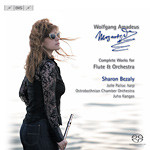
Flute Concertos
 $35.00
Out of Stock
$35.00
Out of Stock6+ weeks add to cart
W.A. MOZART
Flute Concertos
Sharon Bezaly (flute) / Ostrobothnian Chamber Orchestra, Juha Kangas
[ BIS SACD / SACD ]
Release Date: Friday 1 February 2008
This item is currently out of stock. It may take 6 or more weeks to obtain from when you place your order as this is a specialist product.
"I was immediately struck by the dynamic shading the conductor was extracting from the orchestra, each phrase sharply chiselled. A remarkable and fascinating achievement."
(MusicWeb Oct 2005)
Please note: The music on this Hybrid Super Audio CD can be played back in Stereo (CD and SACD) as well
as in 5.0 Surround sound (SACD)
"Spick-and-span, engagingly transparent sound BIS's engineers typically achieve for Sharon Bezaly's sensational new recordig. Bezaly's exquisite, technically immaculate, compelling playing sets new standards in this repertoire, as do Kalevi Aho's stunning cadenzas, composed especially for this recording…her spellbinding artistry and that budget price tag currently sweep the board."
Five Stars ***** BBC Music Mag (November 2005)
"I was immediately struck by the dynamic shading the conductor was extracting from the orchestra, each phrase sharply chiselled. But you can have too much of a good thing and I thought the prissy preening of the second subject (first concerto, first movement) horribly narcissistic. Second subjects seem dangerous territory for Kangas, and that in the equivalent place in the second concerto is equally obnoxious.
Does this herald similar treatment from the soloist? Yes and no, for her basic approach seems along the same lines, yet with more music to it. And at times they are ill-matched. Hear the four repeated notes with which the theme of the finale of the first concerto starts. Kangas gives us authentic-brigade treatment with a vengeance (the orchestra actually plays modern instruments but "authentic" influence is strongly felt), applying a heavy ONE-two-three-ONE-two-three regardless of the actual shape of the phrase, whereas Bezaly makes the first three notes sound like an upbeat leading to the fourth, which sounds the natural and musical thing to do. One day one of these authenticists will have to explain why they think a composer so sublimely musical when he composed should have become mechanically unimaginative when he played, or have tolerated such playing from others.
In the two shorter pieces the orchestra has less to do, and it was these that I enjoyed most.
Is all lost, then? Well, though it will be clear that this Dresden china is far too fragile for me, I suppose there must be people who like Mozart done this way, so if you think it might be you, the performances are certainly expertly realized from their given point of view.
And then, if you're a fan of Kalevi Aho … In theory it's all wrong to write cadenzas in a style of your own which is not that of the composer, but there's the exception to every rule and I can only agree with Bezaly when she writes that "Aho expands on Mozart's musical language so that the cadenzas seem to grow out of the concertos themselves, yet he goes a step further by using the whole spectrum of the modern flute and all the possibilities the instrument offers today". Yes, they really do seem to rise out of the concertos and, by virtue of Bezaly's coolly glinting tone, to transport us effortlessly to snowy northern wastes without sacrilege to the spirit of Mozart himself. A remarkable and fascinating achievement."
(MusicWeb Oct 2005)
Tracks:
Concerto in G major for flute and orchestra, KV313
Andante in C major for flute and orchestra, KV315
Concerto in C major for flute, harp and orchestra, KV299 Rondo in D major for flute and orchestra, KV Anh.184
Concerto in D major for flute and orchestra, KV314
(Cadenzas by Kalevi Aho)



